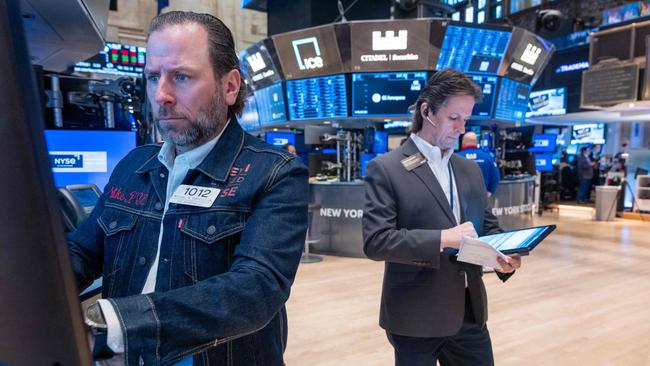‘No landing’ for US depends on inflation: Morgan Stanley
After the fastest rate hikes in a generation, the US economic outlook has swung from a hard landing to a soft landing and more recently to ‘no landing’, Morgan Stanley says.

After the fastest US interest rate hikes in a generation, the US economic outlook has swung from a hard landing to a soft landing and more recently to “no landing”, according to Morgan Stanley.
That may seem like good news for the sharemarket but it depends on what happens to inflation.
The market will get crucial updates on inflation this week when US CPI and PPI data are released.
After two months of upward surprises in US inflation, Fed chair Powell said last week it was “too soon to say whether the recent readings represent more than just a bump”.
If the US inflation numbers overshoot again this month the market may lose patience.
If it looks like an economic reacceleration will underpin inflation, the Fed may delay rate cuts or not cut as much as expected and higher bond yields may challenge lofty valuations in the sharemarket.
Commodity prices could add to inflation worries as crude oil nears $US100 a barrel.
Early last week there were some jitters in the sharemarket as the 10-year bond yield hit a four-month high after a stronger than expected ISM Manufacturing sector survey.
Those fears were assuaged by a weaker than expected US ISM Services sector survey.
By the end of the week, stronger than expected economic data including ISM manufacturing, JOLTS, ADP employment and the crucial non-farm payrolls report backed the no-landing scenario.
However the US sharemarket rebounded on Friday, even as bond yields continued to rise.
The US 10-year bond yield rose 10 basis points to 4.4 per cent and the market-implied chance of a June rate cut fell to 50 per cent. Earlier this year the Fed was expected to start cutting in March.
Fed chair Jerome Powell says the labour market remains relatively tight, but coming into better balance.
The question is whether that rebalancing will be enough to get inflation back down to the 2 per cent target, particularly if the price of commodities from crude oil to copper and gold are surging.
Strong immigration may restrain wages growth but could also add to consumer demand.
Morgan Stanley’s chief US equity strategist and chief investment officer Mike Wilson says a broadening in cyclical leadership suggests the US sharemarket is pricing in the “no landing” scenario.
He recommends “staying up the quality curve” within cyclicals and reiterates his overweight stance on energy, which Morgan Stanley recently upgraded.
Mr Wilson also warns that equities are becoming increasingly correlated to bond yields ahead of the CPI this week.
At the start of the year, he outlined how the three kinds of “landings’’ that were possible for the US economy in 2024 would have different implications for asset prices.
“Just a few months ago, the consensus view skewed toward scenario one, a soft landing,” he said.
“However, the macro data and equity market leadership have started to support the no landing outcome with recent growth data points exceeding most forecasters’ expectations and inflation data remaining a bit stickier than expected.” Mr Wilson says the real takeaway is that consensus expectations have been fickle over the last 12 months because the outcomes have been hard to predict and the data have been volatile.
“While cyclically sensitive stocks and sectors have started to outperform, quality remains a key attribute for the leaders,” he said.
“We think this combination of quality and cyclical factors makes sense in the context of what is still a later cycle rather than an early cycle reacceleration in growth.”
He continues to believe that much of the upside in economic growth over the past year has been the result of government spending, funded by growing budget deficits, which has seen a “crowding out” of smaller and lower quality businesses and a muted recovery in small business sentiment thus far.
As with most fiscal stimulus packages, the plan was for this bridge of support to buy time until a more durable growth outcome driven by organic private income, consumption and spending arrived.
Until this potential outcome is more solidified, Morgan Stanley’s Wilson expects the market to keep trading with a “quality bias”, which could favour some of the so-called Magnificent 7 tech giants.
One risk in this scenario is that the bond market begins to push back on the funding of these deficits before organic growth can re-accelerate in a sustainable way.
Meanwhile, leadership within the equity market continues to broaden, led by cyclical industries including energy, materials, and industrials, which is supportive of the notion that the equity market is beginning to price in a better economic growth environment.
“It’s worth noting that quality cyclicals have continued to outperform the broader market and small caps have persistently underperformed,” Mr Wilson said. “In our view, this suggests that while the market is rotating more pro-cyclically, it still makes sense to stay up the quality curve.”
Another implication of the rise in crude oil prices over the last couple of months is that US petrol prices have pushed materially higher, up 40 per cent from the December lows.
Mr Wilson thinks this is one reason why consumer cyclicals have underperformed more recently.
He prefers commodity cyclicals, particularly energy and the high quality industrial cyclicals.
As the US earnings season starts this week, Morgan Stanley’s Mr Wilson said a moderate downward revision of the March quarter EPS estimate in the past three months should “lead to a lowered bar into reporting season and a solid mid-single digit EPS beat rate”.







To join the conversation, please log in. Don't have an account? Register
Join the conversation, you are commenting as Logout